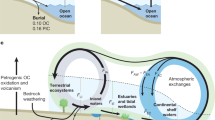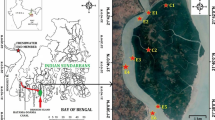Abstract
This paper reports analyses of C pools and fluxes in land-water interface zones completed at the International Workshop: Terrestrial Biospheric Carbon Fluxes; Quantification of Sinks and Sources of CO2 (Bad Harzburg, Germany, March 1–5, 1993). The objective was to determine the role of these zones as global sinks of atmospheric CO2 as part of a larger effort to quantify global C sinks and sources in the past (ca. 1850), the present, and the foreseeable future (ca. 2050). Assuming the world population doubles by the year 2050, storage of atmospheric C in reservoirs will also double, as will river loads of atmospheric C and nutrients. It is estimated that C sinks in temperate and boreal wetlands have decreased by about 50%, from 0.2 to 0.1 Gt C yr−1 since 1850. The total decrease for wetlands may be considerably larger when tropical wetlands are taken into account, however, the area and C density of tropical wetlands are not well known at this time. Changes in cultivation practices and improved sampling of methaneogenesis have caused estimates of CH4 emissions from ricelands to drop substantially from 150 to 60 Tg yr−1. Even with doubled N and P loads, rivers are unlikely to fertilize more than about 20% of the new primary production in the coastal ocean. The source of C for this new production may not be the atmosphere, however, because the coastal ocean exchanges large quantities of DIC with the open ocean. Until the C fluxes from air-sea exchange of CO2 and DIC are better quantified, the C-sink potential of the coastal ocean will remain a major uncertainty in the global C cycle. Analysis of model simulations of oceanic C uptake reconfirmed that the open ocean appears to take up about 2.0 Gt C yr−1 from the atmosphere and that model estimates are in better accord now, ±0.5 Gt C yr−1, than ever before. Land use management must consider the unique C sinks in coastal and alluvial wetlands in order to minimize the future negative impacts of agriculture and urban development. Long-term monitoring will be essential to prove the success, or failure, of management practices to sustain wetlands in the future. Relative to the other systems examined at the workshop, the C-sink capacity of the ocean (excluding estuaries) is not likely to be measurably affected in the foreseeable future by the management scenarios considered at the workshop.
Similar content being viewed by others
References
Apps, M.J., Kurz, W.A., Luxmoore, R., Nilsson, L.-O, Sedjo, R.A., Schmidt, R., Simpson, L.G., and Vinson, T.S.: this volume.
Armentano, T.V. and Menges, E.S.: 1986,Journal of Ecology 74, 755.
Brewer, P.G.: 1978,Geophys. Res. Lett. 5, 997.
Broecker, W.S., Takahashi, T., Peng, T.-H.: 1985,Reconstruction of past atmospheric CO 2 contents from the chemistry of the contemporary ocean, an evaluation, DOE Tech. Rep., DOE/OR-857, U.S. Department of Energy, Washington, D.C., pp. 79.
Chen C.T., Poission, A., and Goyet, C: 1986,Preliminary data report for the INDIVAT 1 and INDO1/INDIVAT 3 cruises in the Indian Ocean, U.S. Department of Energy, pp. 106.
Chen, C.T.A.: 1985,Cont. Shelf Res. 4, 465.
Cole, C.V., Flach, K., Lee, J., Sauerbeck, D., and Stewart, B.: this volume.
Downing, J.P. and Cataldo, D.A.: 1992,Water, Air, and Soil Pollution 64, 439.
Drake, B.G.: 1992,Water, Air, and Soil Pollution 64, 25.
Dunton, K.H.: 1984, An Annual Carbon Budget for an Arctic kelp Community, in: Barnes, P.W., Schell, D.M., and Reimnitz, E. (eds),The Alaskan Beaufort Sea: Ecosystems and Environments, Academic Press, Inc., pp. 311–323.
Edgerton, L.T.: 1990,The Rising Tide, Gobal Warming and World Sea Levels, Island Press, Washington, D.C.
Gorham E.: 1991,Ecological Applications 1, 182.
Houghton, J.T., Jenkins, G.J. and Ephraums, J.J.: 1990,Climate Change, the IPCC Scientific Assessment, Cambridge University Press, New York, pp. 365.
Keeling, C.D., Piper, S.C., Heimann, M.: 1989, in: Peterson H., (ed),Aspects of Climate Variability in the Pacific and the Western Americas, American Geophysical Union, Washington D.C., pp. 165–236.
Kempe, S. and Pegler, K.: 1991,Tellus 43B, 224.
Khalil, M.A.K. and Rasmussen, R.A.: 1993a,Chemosphere 1–4, 803.
Khalil, M.A.K. and Rasmussen, R.A.: 1993b,Chemosphere 1–4, 127.
Kjerfve, B.: 1988,Hydrodynamics of estuaries, CRC Press, Inc. Boca Raton, Florida.
Meybeck, M.: 1982,Amer. J. Sci. 282, pp. 401.
Mulholland, P.J. and Elwood, J.W.: 1982,Tellus 34, 490.
Meybeck, M.: 1993, C, N, P and S in Rivers: From Sources to Global Inputs, in: Wollast R., Mackenzie F.T. and Chou L. (eds),Interaction of C, N, P and S Biogeochemical Cycles and Global Change, Springer-Verlag, pp. 163–193.
Neue, N.U., Becker-Heidmann, P. and Scharpenseel, H.W.: 1990, A review of Rice Soil Agronomy and Chemistry, in: Bouwman A.F. (ed),Soils and the Greenhouse Effect, John Wiley & Sons, pp. 61–127.
Orr, J.C.: this volume.
Orr, J.C. and Sarmiento, J.L.: 1992,Water, Air, and Soil Pollution 64, 405.
Quay, P.D., Tilbrook, B., Wong, C.S.: 1992,Science 256, 74.
Ritschard, R.L.: 1992,Water, Air, and Soil Pollution 64, pp. 289–303.
Sampson, R.N., Apps. M.J., Brown, S., Cole, C.V., Downing, J.P., Heath, L., Ojima, D.S., Smith, T.M., Solomon, A.M., Wisniewski, J.: this volume.
Sarmiento, J.L.: 1992, Biogeochemical Ocean Models, in: Trenberth, K. (ed),Climate Systems Modeling, Cambridge University Press, Cambridge.
Sarmiento, J.L.: 1991,Global Biogeochem. Cycles 5, 309.
Sarmiento, J.L. and Orr, J.C.: 1991,Limnol Oceanogr. 36, 1928.
Sarmiento, J.L., Orr, J.C., and Siegenthaler, U.: 1992,J. Geophys. Res 97 No. C3, 3621.
Sarmiento, J.L. and Siegenthaler, U.: 1991, in: Falkowski P. and Woodhead A. (eds),New Production and the Global Carbon Cycle, Plenum, New York.
Sarmiento, J.L. and Sundquist, E.T.: 1992,Nature 356, 589.
Scharpenseel, H-W.: this volume.
Shiller, A.M.: 1981,J. Geophys. Res.,86, 11,083.
Smith, S.V. and Hollibaugh, J.T.: 1993, Coastal Metabolism and the Oceanic Organic Carbon Balance,Reviews of Geophysics 31, 75.
Spencer, D.F.: 1993, An Overview of Energy Technology Options for Carbon Dioxide Mitigation, in: Rosen L. and Glasser R. (eds),Climate Change and Energy Policy, American Institute of Physics, New York, pp. 176–191.
Sundquist, E.T.: 1993,Science 259, 934.
Takahashi, T., Goddard, J., Sutherland, S., Chipman, D.W. and Breeze, C.S.: 1986,Seasonal and Geographic Variability of Carbon Dioxide Sink/Source in the Oceanic Areas: Observations in the North and Equatorial Pacific Ocean, 1984–1986 and Global Survey, Technical Report to U.S. DOE Carbon Dioxide Research Division, Washington, D.C., pp. 65.
Tans, P.P., Fung, I.Y., and Takahashi, T.: 1990,Science 247, 1431.
Thom, R.M.: submitted,Water, Air and Soil Pollution.
Twilley, R.R., Chen, R.H., Hargis, T.: 1992,Water, Air, and Soil Pollution 64, 265.
Twilley, R.R., Chen, R.H., Bouergois, J.: submitted,Water, Air and Soil Pollution.
Van Bennekom, A.J. and Salomons, W.: 1981, Pathways of nutrients and organic matter from land to ocean through rivers, in: SCORE,Proceedings of the Workshop on River Inputs to Ocean Systems (RIOS), New York, United Nations, pp. 33.
Walsh, J.J.: 1991,Nature 350, 53.
Walsh, J.J.: 1988,On the Nature of Continental Shelves, Academic Press, New York, pp. 521.
Watson, A.J., Robinson, C., Robertson, J.E., Williams, P.J.IeB., and Fasham, M.J.R.: 1991,Nature 350, No.6313, 50.
Wollast, R.: 1983, Interactions in Estuaries and Coastal Waters, in: Bolin B. and Book R.B. (eds),The Major Biogeochemical Cycles and Their Interactions, John Wiley & Sons, New York, pp. 385–407.
Wollast, R.: 1991, The coastal carbon cycle: fluxes, sources, and sinks, in: Mantoura, R.F.C., Martin, J.M. and Wollast, R. (eds),Ocean Margin Processes in Global Change, Plymouth Marine Lab, Plymouth, U.K., pp. 365–381.
Author information
Authors and Affiliations
Rights and permissions
About this article
Cite this article
Downing, J.P., Meybeck, M., Orr, J.C. et al. Land and water interface zones. Water Air Soil Pollut 70, 123–137 (1993). https://doi.org/10.1007/BF01104992
Issue Date:
DOI: https://doi.org/10.1007/BF01104992




